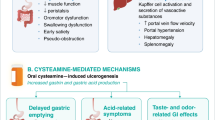Abstract
Oral cysteamine therapy prevents natural disease progression in children with cystinosis, but it may cause severe gastrointestinal (GI) symptoms through gastric acid-hypersecretion. The purpose of this study was to assess the value of esomeprazole in controlling cysteamine-induced acid-hypersecretion and GI symptoms in children with cystinosis. Subjects underwent upper GI endoscopy and biopsy, serum gastrin and cysteamine measurements as well as acid secretion studies (basal, maximal and peak acid output, BAO, MAO, PAO) before and during esomeprazole therapy. A symptom score (maximum 14 points) was devised to monitor symptoms. Twelve children (mean age 5.8 years) were studied. Cysteamine ingestion resulted in mean MAO and PAO significantly higher than mean BAO, both before and during esomeprazole therapy. PAO was usually within 60 min of cysteamine ingestion. Esomeprazole therapy significantly reduced MAO (P<0.01) and PAO (P<0.01). The mean symptom score fell from 6.4 to 0.7 (P<0.0001) during esomeprazole therapy. The mean final dose of esomeprazole was 1.7 mg/kg per day (range 0.7 mg/kg per day to 2.75 mg/kg per day). Plasma cysteamine levels were not affected by acid-suppression therapy. One child had multi-nucleated parietal cells. Cysteamine-induced gastric acid-hypersecretion and GI symptoms are dramatically reduced with esomeprazole therapy. Esomeprazole does not alter cysteamine absorption and is very well tolerated in children.



Similar content being viewed by others
References
Gahl WA, Thoene JG, Schneider JA (2002) Cystinosis. N Engl J Med 347:111–121
Gahl WA, Reed GF, Thoene JG, Schulman JD, Rizzo WB, Jonas AJ, Denman DW, Schlesselman JJ, Corden BJ, Schneider JA (1987) Cysteamine therapy for children with nephropathic cystinosis. N Engl J Med 316:971–977
Markello TC, Bernardini IM, Gahl WA (1993) Improved renal function in children with cystinosis treated with cysteamine. N Engl J Med 328:1157–1162
Elenberg E, Norling LL, Kleinman RE, Ingelfinger JR (1998) Feeding problems in cystinosis. Pediatr Nephrol 12:365–370
Dohil R, Newbury RO, Sellers ZM, Deutsch R, Schneider JA (2003) The evaluation and treatment of gastrointestinal disease in children with cystinosis receiving cysteamine. J Pediatr 143:224–230
Pfeiffer DC, Pfeiffer CJ, Szabo S (1987) Development of cysteamine-induced ultrastructural surface changes on duodenal mucosa. Lab Invest 56:444–450
Kirkegaard P, Poulsen SS, Loud FB, Halse C, Christiansen J (1980) Cysteamine-induced duodenal ulcer and acid secretion in the rat. Scand J Gastroenterol 15:621–624
Poulsen SS, Olsen PS, Kirkegaard P (1985) Healing of cysteamine-induced duodenal ulcers in the rat. Dig Dis Sci 30:161–167
Wenner WJ, Murphy JL (1997) The effects of cysteamine on the upper gastrointestinal tract of children with cystinosis. Pediatr Nephrol 11:600–603
Lindstedt G, Olbe L, Kilander AF, Armbrecht U, Jagenburg R, Runsteen D, Lundberg PA (1985) Analytical and clinical evaluation of a radioimmunoassay for gastrin. Clin Chem 31:76–82
Guan X HG, Dwivedi C, Matthees DP (2003) A simultaneous liquid chromatography/mass spectrometric assay of glutathione, cysteine, homocysteine and their disulfides in biological samples. J Pharm Biomed Anal 31:251–261
Isenberg JI, Grossman MI, Maxwell V, Walsh JH (1975) Increased sensitivity to stimulation of acid secretion by pentagastrin in duodenal ulcer. J Clin Invest 5:330–337
Carpenter HA, Talley NJ (1995) Gastroscopy is incomplete without biopsy: clinical relevance of distinguishing gastropathy from gastritis. Gastroenterology108:917–924
Dohil R, Hassall E, Jevon G, Dimmick J (1999) Gastritis and gastropathy of childhood. J Pediatr Gastroenterol Nutr 29:378–394
Gillett P, Hassall E (2000) Pediatric gastrointestinal mucosal biopsy. Special considerations in children. Gastrointest Endosc Clin N Am 10:669–712
Schwartz GJ HG, Edelman CM, Spitzer A (1976) A simple estimate of glomerular filtration rate in children derived from body length and plasma creatinine. Pediatrics 58:259–263
Selye H, Szabo S (1973) Experimental model for production of perforating duodenal ulcers by cysteamine in the rat. Nature 244:458–459
Ishii Y, Fujii Y, Homma M (1976) Gastric acid stimulating action of cysteamine in the rat. Eur J Pharmacol 36:331–336
Lichtenberger LM, Szabo S, Trier JS (1977) Duodenal ulcerogens, cysteamine and propionitrile, stimulate serum gastrin levels in the rat. Gastroenterology 73:1305–1308
Lichtenberger LM, Szabo S, Reynolds ES (1977) Gastric emptying in the rat is inhibited by the duodenal ulcerogens, cysteamine and propionitrile. Gastroenterology 73:1072–1076
Kirkegaard P, Poulsen SS, Halse C, Loud FB, Skov Olsen P, Christiansen J (1981) The effect of cysteamine on the Brunner gland secretion in the rat. Scand J Gastroenterol 16:93–96
Poulsen SS, Kirkegaard P, Skov Olsen P, Christiansen J (1981) Brunner’s glands of the rat during cysteamine ulceration. Scand J Gastroenterol 16:459–464
Kimonis VE, Troendle J, Rose SR, Yang ML, Markello TC, Gahl WA (1995) Effects of early cysteamine therapy on thyroid function and growth in nephropathic cystinosis. J Clin Endocrinol Metab 80:3257–3261
Miner P Jr KP, Chen Y, Sostek M (2003) Gastric acid control with esomeprazole, lansoprazole, omeprazole, pantoprazole, and rabeprazole: a five-way crossover study. Am J Gastroenterol 98:2616–2620
Acknowledgments
Support was provided by AstraZeneca, Wilmington, Delaware, USA and National Institute of Health grant MO1RR00827.
Author information
Authors and Affiliations
Corresponding author
Rights and permissions
About this article
Cite this article
Dohil, R., Fidler, M., Barshop, B. et al. Esomeprazole therapy for gastric acid hypersecretion in children with cystinosis. Pediatr Nephrol 20, 1786–1793 (2005). https://doi.org/10.1007/s00467-005-2027-1
Received:
Revised:
Accepted:
Published:
Issue Date:
DOI: https://doi.org/10.1007/s00467-005-2027-1




